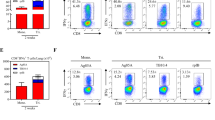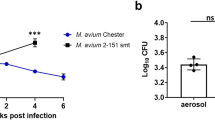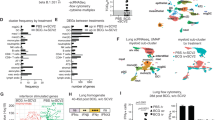Abstract
Granulysin is a cytolytic molecule with perforin and granzymes that is expressed by activated human CTLs, NK and γδ T cells, and it has broad antimicrobial activity, including to drug-sensitive and drug-resistant Mycobacterium tuberculosis. We hypothesized that approaches facilitating the expression of granulysin in M. tuberculosis-infected host cells in the lung may provide a novel treatment strategy for pulmonary TB. In this study, a recombinant replication-deficient adenovirus serotype 5-based rAdhGLi was constructed that expressed human granulysin in the cytosol of the U937 and RAW264.7 macrophage-like cell lines as confirmed by western blotting and co-localization technology using indirect immunofluorescence staining. Ninety-six hours after both cell lines were infected with M. tuberculosis, acid-fast staining and enumeration demonstrated that rAdhGLi-treated cells had a lower colony-forming units (CFU) of intracellular bacteria than culture medium or AdNull controls. Granulysin was only expressed in the lung and not in other organs following inhalation of rAdhGLi. In particular, immunocompetent BALB/c mice or SCID mice intranasally infected with ~200 CFU of virulent M. tuberculosis H37Rv intranasally were treated with rAdhGLi, and they showed decreased bacterial loads in the lung when compared with phosphate-buffered saline or AdNull controls. Importantly, a clear dose-dependent rAdhGLi treatment efficacy was found in infected BALB/c mice, with the most significant reduction in lung bacteria obtained in BALB/c mice treated with 109 plaque-forming units of rAdhGLi without any pathological changes. Our study indicates that rAdhGLi may be used as a novel and efficient treatment strategy with the capability to directly kill intracellular M. tuberculosis.
This is a preview of subscription content, access via your institution
Access options
Subscribe to this journal
Receive 12 print issues and online access
$259.00 per year
only $21.58 per issue
Buy this article
- Purchase on Springer Link
- Instant access to full article PDF
Prices may be subject to local taxes which are calculated during checkout








Similar content being viewed by others
References
WHO. Global Tuberculosis Report. Geneva: Switzerland, 2014.
LoBue P . Extensively drug-resistant tuberculosis. Curr Opin Infect Dis 2009; 22: 167–173.
Gandhi NR, Moll A, Sturm AW, Pawinski R, Govender T, Lalloo U et al. Extensively drug-resistant tuberculosis as a cause of death in patients co-infected with tuberculosis and HIV in a rural area of South Africa. Lancet 2006; 368: 1575–1580.
Stenger S, Hanson DA, Teitelbaum R, Dewan P, Niazi KR, Froelich CJ et al. An antimicrobial activity of cytolytic T cells mediated by granulysin. Science 1998; 282: 121–125.
Gansert JL, Kiessler V, Engele M, Wittke F, Rollinghoff M, Krensky AM et al. Human NKT cells express granulysin and exhibit antimycobacterial activity. J Immunol 2003; 170: 3154–3161.
Farouk SE, Mincheva-Nilsson L, Krensky AM, Dieli F, Troye-Blomberg M . Gamma delta T cells inhibit in vitro growth of the asexual blood stages of Plasmodium falciparum by a granule exocytosis-dependent cytotoxic pathway that requires granulysin. Eur J Immunol 2004; 34: 2248–2256.
Walch M, Dotiwala F, Mulik S, Thiery J, Kirchhausen T, Clayberger C et al. Cytotoxic cells kill intracellular bacteria through granulysin-mediated delivery of granzymes. Cell 2014; 157: 1309–1323.
Toro JC, Hoffner S, Linde C, Andersson M, Andersson J, Grundstrom S . Enhanced susceptibility of multidrug resistant strains of Mycobacterium tuberculosis to granulysin peptides correlates with a reduced fitness phenotype. Microbes Infect 2006; 8: 1985–1993.
Okada M, Kita Y . Tuberculosis vaccine development: The development of novel (preclinical) DNA vaccine. Hum Vaccin 2010; 6: 297–308.
Guo Y, Luan G, Shen G, Wu L, Jia H, Zhong Y et al. Production and characterization of recombinant 9 and 15 kDa granulysin by fed-batch fermentation in Pichia pastoris. Appl Microbiol Biotechnol 2013; 97: 7669–7677.
Walch M, Eppler E, Dumrese C, Barman H, Groscurth P, Ziegler U . Uptake of granulysin via lipid rafts leads to lysis of intracellular Listeria innocua. J Immunol 2005; 174: 4220–4227.
Santosuosso M, McCormick S, Xing Z . Adenoviral vectors for mucosal vaccination against infectious diseases. Viral Immunol 2005; 18: 283–291.
Santosuosso M, Zhang X, McCormick S, Wang J, Hitt M, Xing Z . Mechanisms of mucosal and parenteral tuberculosis vaccinations: adenoviral-based mucosal immunization preferentially elicits sustained accumulation of immune protective CD4 and CD8 T cells within the airway lumen. J Immunol 2005; 174: 7986–7994.
Radosevic K, Wieland CW, Rodriguez A, Weverling GJ, Mintardjo R, Gillissen G et al. Protective immune responses to a recombinant adenovirus type 35 tuberculosis vaccine in two mouse strains: CD4 and CD8 T-cell epitope mapping and role of gamma interferon. Infect Immun 2007; 75: 4105–4115.
Yao XL, Nakagawa S, Gao JQ . Current targeting strategies for adenovirus vectors in cancer gene therapy. Curr Cancer Drug Targets 2011; 11: 810–825.
Liu B, Liu S, Qu X, Liu J . Construction of a eukaryotic expression system for granulysin and its protective effect in mice infected with Mycobacterium tuberculosis. J Med Microbiol 2006; 55: 1389–1393.
Yi Z, Fu Y, Yang C, Li J, Luo X, Chen Q et al. Recombinant M. smegmatis vaccine targeted delivering IL-12/GLS into macrophages can induce specific cellular immunity against M. tuberculosis in BALB/c mice. Vaccine 2007; 25: 638–648.
Tewary P, Yang D, de la Rosa G, Li Y, Finn MW, Krensky AM et al. Granulysin activates antigen-presenting cells through TLR4 and acts as an immune alarmin. Blood 2010; 116: 3465–3474.
Deng A, Chen S, Li Q, Lyu SC, Clayberger C, Krensky AM . Granulysin, a cytolytic molecule, is also a chemoattractant and proinflammatory activator. J Immunol 2005; 174: 5243–5248.
Ginsberg AM, Spigelman M . Challenges in tuberculosis drug research and development. Nat Med 2007; 13: 290–294.
Zhang Y . Advances in the treatment of tuberculosis. Clin Pharmacol Ther 2007; 82: 595–600.
Sacchettini JC, Rubin EJ, Freundlich JS . Drugs versus bugs: in pursuit of the persistent predator Mycobacterium tuberculosis. Nat Rev Microbiol 2008; 6: 41–52.
Gonzalez-Juarrero M . Immunity to TB and targets for immunotherapy. Immunotherapy 2012; 4: 187–199.
Wang CC, Zhu B, Fan X, Gicquel B, Zhang Y . Systems approach to tuberculosis vaccine development. Respirology 2013; 18: 412–420.
Mata-Espinosa DA, Mendoza-Rodriguez V, Aguilar-Leon D, Rosales R, Lopez-Casillas F, Hernandez-Pando R . Therapeutic effect of recombinant adenovirus encoding interferon-gamma in a murine model of progressive pulmonary tuberculosis. Mol Ther 2008; 16: 1065–1072.
Francisco-Cruz A, Mata-Espinosa D, Estrada-Parra S, Xing Z, Hernandez-Pando R . Immunotherapeutic effects of recombinant adenovirus encoding granulocyte-macrophage colony-stimulating factor in experimental pulmonary tuberculosis. Clin Exp Immunol 2013; 171: 283–297.
Romano M, Huygen K . DNA vaccines against mycobacterial diseases. Expert Rev Vaccines 2009; 8: 1237–1250.
Harth G, Horwitz MA, Tabatadze D, Zamecnik PC . Targeting the Mycobacterium tuberculosis 30/32-kDa mycolyl transferase complex as a therapeutic strategy against tuberculosis: Proof of principle by using antisense technology. Proc Natl Acad Sci USA 2002; 99: 15614–15619.
Rosas-Taraco AG, Higgins DM, Sanchez-Campillo J, Lee EJ, Orme IM, Gonzalez-Juarrero M . Local pulmonary immunotherapy with siRNA targeting TGFbeta1 enhances antimicrobial capacity in Mycobacterium tuberculosis infected mice. Tuberculosis (Edinb) 2011; 91: 98–106.
Cooper AM . Cell-mediated immune responses in tuberculosis. Annu Rev Immunol 2009; 27: 393–422.
Stegelmann F, Bastian M, Swoboda K, Bhat R, Kiessler V, Krensky AM et al. Coordinate expression of CC chemokine ligand 5, granulysin, and perforin in CD8+ T cells provides a host defense mechanism against Mycobacterium tuberculosis. J Immunol 2005; 175: 7474–7483.
Ochoa MT, Stenger S, Sieling PA, Thoma-Uszynski S, Sabet S, Cho S et al. T-cell release of granulysin contributes to host defense in leprosy. Nat Med 2001; 7: 174–179.
Klucar P, Barnes PF, Kong Y, Samten B, Tvinnereim A, Spallek R et al. Characterization of effector functions of human peptide-specific CD4+ T-cell clones for an intracellular pathogen. Hum Immunol 2008; 69: 475–483.
Andersson J, Samarina A, Fink J, Rahman S, Grundstrom S . Impaired expression of perforin and granulysin in CD8+ T cells at the site of infection in human chronic pulmonary tuberculosis. Infect Immun 2007; 75: 5210–5222.
Di Liberto D, Buccheri S, Caccamo N, Meraviglia S, Romano A, Di Carlo P et al. Decreased serum granulysin levels in childhood tuberculosis which reverse after therapy. Tuberculosis (Edinb) 2007; 87: 322–328.
Sekiya M, Ohwada A, Katae M, Dambara T, Nagaoka I, Fukuchi Y . Adenovirus vector-mediated transfer of 9 kDa granulysin induces DNA fragmentation in HuD antigen-expressing small cell lung cancer murine model cells. Respirology 2002; 7: 29–35.
Houben D, Demangel C, van Ingen J, Perez J, Baldeon L, Abdallah AM et al. ESX-1-mediated translocation to the cytosol controls virulence of mycobacteria. Cell Microbiol 2012; 14: 1287–1298.
van der Wel N, Hava D, Houben D, Fluitsma D, van Zon M, Pierson J et al. M. tuberculosis and M. leprae translocate from the phagolysosome to the cytosol in myeloid cells. Cell 2007; 129: 1287–1298.
Acknowledgements
This work was supported by grants from the National Mega-Projects of Science Research for the 12th Five-Year Plan (no. 2012ZX10003008-005), the Natural Science Foundation of China (no. 30671861) and Wuhan Bureau of Science and Technology (no. 2015060101010029).
Author information
Authors and Affiliations
Corresponding author
Ethics declarations
Competing interests
The authors declare no conflict of interest.
Rights and permissions
About this article
Cite this article
Ma, J., Lu, J., Huang, H. et al. Inhalation of recombinant adenovirus expressing granulysin protects mice infected with Mycobacterium tuberculosis. Gene Ther 22, 968–976 (2015). https://doi.org/10.1038/gt.2015.73
Received:
Revised:
Accepted:
Published:
Issue Date:
DOI: https://doi.org/10.1038/gt.2015.73



